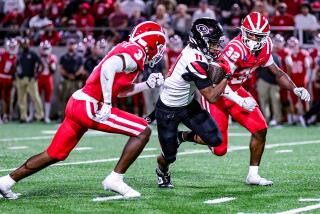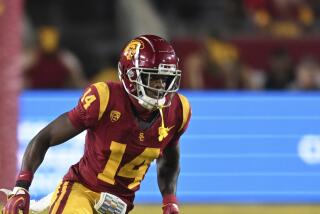Not Everybody Can Have a Ball in SDSU’s Backfield : College football: Five suitors line up for a chance in Aztecs’ one-back offense.
- Share via
SAN DIEGO — You are a running back, and you are thinking of walking onto the San Diego State football team next year.
You visit the campus and are quite impressed. It is spring and the weather is warming up. The sky is bright blue, the grass is deep green, the people smile, even the beaches beckon . . .
But no. You’re here for football, so football it will be.
Specifically running the football. You walk over to the football operations building, through the courtyard and into the lobby outside of Coach Al Luginbill’s office. You look at the framed pictures of SDSU’s near-upset of Miami last December.
The talk is of SDSU’s one-back offense. It is a unit that ranked third in the nation in total offense last year. The Aztecs run about 90 plays a game, and Luginbill likes to average between 45 and 60 rushing plays.
You could handle playing in this offense, you think. All eyes on you. Two fifty-four, two fifty-four . . . ready . . . hup! . . . hup! You spring forward and take the handoff. Cut left, cut right, daylight!
Just one hitch. There are a few guys in line to play right now. And the line forms over there.
You start with T.C. Wright, who led the Aztecs with 730 yards and a 6.3 yard-per-carry average last year. He transferred from Mesa (Ariz.) Community College, where he was a community college All-American. This guy, as they say, can go north and south. He breaks tackles, he runs through tackles and he runs around tackles. Against Miami last year, Wright, a senior in the fall, exploded for 112 yards, the most by a back against the Hurricanes last season.
Earlier in the year, Wright didn’t even play against UCLA. The week before UCLA, at Wyoming, Wright cut the wrong way a couple of times and ruined some plays. So, against UCLA, he sat.
“I was really down,” said Wright, who will be a senior. “It was the first time I’ve sat out a whole game since way back in Pop Warner.”
The Aztecs had a couple of weeks off after that game, and Wright went home to Phoenix to think. He thought about not coming back. By the time the Miami game came, Wright was glad he had returned.
Still, he didn’t play as much as he would have preferred.
“I made up my mind to stick it out whether I get one carry or 20 carries,” Wright said. “It made me appreciate running the football. Some games, I had less carries and more yards--because I’d run every carry like it was my last carry.”
Larry Maxey is the next name you come across. He played defensive back as a freshman, started his sophomore year as a wide receiver and then was switched to running back in time for the fourth game of the season.
Maxey, a junior-to-be, took to running back like SDSU students take to the sun. In eight games at the position, he gained 492 yards, had four touchdowns and consecutive 100-yard rushing games against Wyoming and UCLA.
He is a nimble, slashing type of back who jazzed up the SDSU offense at times last season. But he, too, doesn’t get to play as much as he would like.
“It gets discouraging,” Maxey said. “All of us out there, we’re all competitors. We all want to do well. At the same time, you want your friends to do well.”
Maxey and Wright, the top two backs this spring, have developed a kinship.
“We try to push each other,” Maxey said. “But in the back of your mind, you know you want to do better than he does.”
Now, it would be one thing if the two only had to worry about each other for the one running back position. But, no.
You find out about Curtis Butts. He has been a backup for two years. People first noticed him two seasons ago when he rushed for 156 yards on 17 carries and scored three touchdowns in a game against New Mexico.
Butts, a power back, became a short-yardage guy last year and scored a team-high 13 touchdowns. He also rushed for a total of 365 yards.
“My role is to pick up short yardage, to score when we get down inside the five,” Butts said. “I wish I played more, but I’m not a selfish person. If that’s my role, I’ll go out and give 100% and make the backs behind me work that much harder.”
Butts, who will be a senior, was a walk-on as a freshman who worked hard enough to earn a scholarship. He has battled throughout his career, so he is used to this. Five backs who can play? Six? Why worry?
“My opportunity will come,” Butts said. “I’ve been there--I know the taste of making a 71-yard run.”
He tells you about the 71-yard touchdown run he had last year against Cal State Long Beach. You sit, listening hard and dreaming harder.
It’s afternoon now, so you walk over and watch practice. You have several dozen trophies at home representing your past football achievements. You are confident in your ability, but you figure that if you do decide to walk onto this team, you will start out behind these three guys--Wright, Maxey and Butts.
Then you learn about two more who aren’t even here. Tommy Booker, a senior and former Parade All-American, has been excused from spring practice to take care of some personal problems, but certainly figures in the mix since he started last year’s season opener at Oregon. Kipp Jeffries, a sophomore, has been excused from all but a couple of spring practices to play baseball.
You figure that, at the very least, Booker and Jeffries will be in the doghouse by missing spring drills. Wrong, says Luginbill. They both know the offense and know what they have to do to get ready.
And then, of course, there are at least three more running backs on the roster waiting for their chances.
You can see clearly now:
Too many running backs, too few footballs.
“It took me a long time to realize my situation,” Jeffries said. “I’m seeing the light now. There’s a lot of competition. It’s tough to realize that it’s going to be awhile (before opportunity arrives).
“The way I look at it, though, is that I’m the youngest of the group. After this season, it will be just Larry and me left . . . and the new guys.”
Of course, there is at least one person who is happy about the overabundance of backs.
“You better have three excellent running backs (in a one-back offense),” Luginbill said. “They take a pounding. There are no secrets as to who is going to carry the ball. No deception. You better have three guys, and you’d like to have four. That way, if one goes down, now you’re at three. If two go down, you’re real nervous.”
Luginbill acknowledged that each the backs wants to play more. But he says they are at their best when they are sharing the load. If one back gets hot, Luginbill likes to stay with him. If not, Luginbill likes to alternate the backs by series.
SDSU RUSHERS ’90
Player Att Net Avg TD T.C. Wright 116 754 6.3 6 Larry Maxey 115 514 4.3 4 Curtis Butts 89 377 4.1 13 Tommy Booker 65 298 4.2 3 Kipp Jeffries 15 41 2.2 1
More to Read
Go beyond the scoreboard
Get the latest on L.A.'s teams in the daily Sports Report newsletter.
You may occasionally receive promotional content from the Los Angeles Times.










